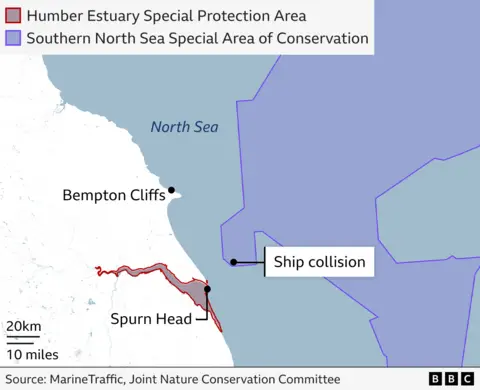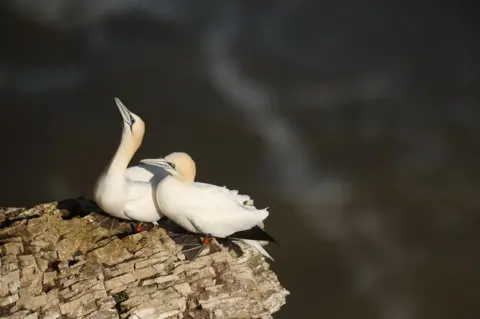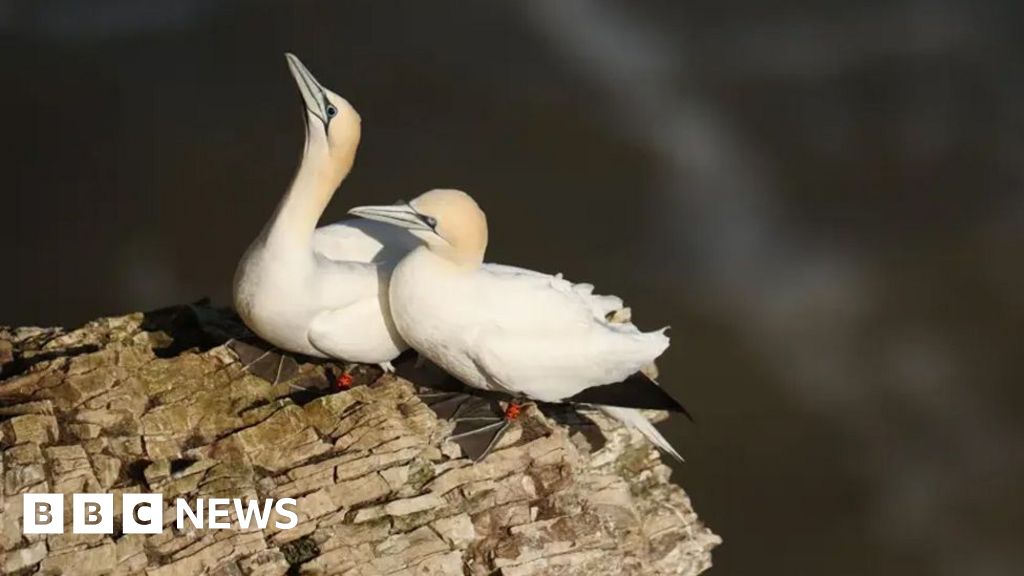Climate and science reporter, BBC News
Climate and science team, BBC News
 Lee Whitaker/Getty Images
Lee Whitaker/Getty ImagesEnvironmental organisations and the UK authorities are assessing how damaging the collision of an oil tanker and a cargo ship in the North Sea will be for marine species and nearby wildlife populations.
It’s still too early to tell whether it will have a major impact, and weather conditions in coming days will be a major factor.
But a lot will depend on exactly which toxic chemicals have been spilled and how much of them.
What might be on board?
Maritime operations company, Crowley, which was managing the oil tanker the MV Stena Immaculate, has confirmed that it was carrying 220,000 barrels of jet fuel in 16 containers at the time of the incident.
It was not clear on the status of all the containers but Crowley said one had “ruptured” and was leaking fuel into the sea.
The contents of the cargo ship, the Solong, which crashed into the tanker have been less clear.
Lloyds List, a shipping data company, said on Monday that it was carrying sodium cyanide.
But on Tuesday Ernst Russ, owners of the cargo ship said: “We are able to confirm that there are no containers on board ladened with sodium cyanide.
“There are four empty containers that have previously contained the hazardous chemical and these containers will continue to be monitored.”
It remains unclear if the ship was carrying other contents at the time of the crash.
What are the dangers of jet fuel and sodium cyanide?
Jet fuel is a toxic substance that can be lethal to marine organisms and other animals like seabirds if ingested.
The level of toxicity is dependent on the crude oil that it has been refined from.
Sodium cyanide, which is used in industry including for metal cleaning, is a also a toxic substance and poisonous for living organisms as it disrupts cell function and leads to oxygen starvation.
Sodium cyanide is also highly soluble in water and it can react vigorously to produce the gas hydrogen cyanide – which is also toxic.
The confirmation that it was only empty containers on board will allay some concerns about environmental damage and make the clean-up operation easier.
The third consideration for authorities will be whether the fuel used to run both ships – the bunker fuel – has also leaked out.
Marine fuel is a lot heavier than jet fuel and can remain in the environment for longer.
Alex Lukyanov at the University of Reading, UK, said. “Marine diesel can smother habitats and wildlife, affecting their ability to regulate body temperature, potentially resulting in death.”
“The environmental toll could be severe,” he said.
Graham Stuart, the local MP for Beverley and Holderness, said on Tuesday that it appears “there is no evidence so far of any of the heavy engine oil leaking from either ship”. But he added that this is still possible.

What mitigation can be taken?
The Marine Accident Investigation Branch is overseeing the operation to respond to the incident and clean up any pollution.
Melanie Onn, the MP for Great Grimsby and Cleethorpes, told BBC Radio 4’s Today programme that the Maritime and Coastguard Agency (MCA) is currently doing an evaluation of the contamination risk and working with the owners of both of the vessels to plan a salvage operation.
Prof Alastair Hay, emeritus professor of environmental toxicology at the University of Leeds said: “The priority, I imagine, for the crews trying to contain the damage, will be to extinguish the fires and keep vessels afloat. This will reduce the quantity of chemicals entering the water and the risk for wildlife downstream.”
The fire that broke out following the crash will have helped to burn off some of the jet fuel but testing kits are being set to the site to confirm there is no residue remaining.
Frode Vikebø, research manager at the Institute of Marine Research said that the UK government will be modelling the spread of any contaminants at sea, considering ocean circulation and weather conditions, as part of “standard procedure”.
In terms of mitigation, Dr Karen Purnell, former director of ITOPF – which advises governments on maritime pollution, said the first approach would be to let the jet fuel “dissipate naturally where possible and avoiding deliberate containment.”
If any jet fuel did make it to shore, she said: “Flushing the shoreline to remobilise the fuel and perhaps directing it into absorbent booms or mats for later disposal could be an option.” But she said the approach would differ depending on the different types of environment, for example whether there were wetlands.
 Dan Kitwood/Getty Images
Dan Kitwood/Getty ImagesWhat wildlife may be affected?
The collision happened within an environmentally rich area – both for marine species but also onshore populations of birds who feed on fish and other aquatic organisms.
The Humber Estuary is a site of special scientific interest and along with Bempton Cliffs Nature Reserve supports more than half a million birds annually including pink footed geese, puffins, avocets and bar-tailed godwits.
Within the wider marine environment at this time of year there are breeding seals and harbour porpoises.
Martin Slater, Director of Operations at Yorkshire Wildlife Trust said the time of the year that this spill has occurred is particularly worrying.
“Many birds are gathering offshore on the sea ahead of the nesting season and we still have wintering waders – plus migrant birds stopping here – so we’re very worried indeed about the threat to these birds,” he said.
There is also concern for wildlife further south of the incident to which the jet fuel may spread depending on the wind and sea conditions.
The area off Lincolnshire’s coast is “a unique habitat for fish where seabirds and cetaceans feed” explained Mr Slater.
Ecology experts have pointed out that animals do have reactionary mechanisms that mean the noise and smell of the crash will have alerted them to dangers and they could have already vacated the area.


